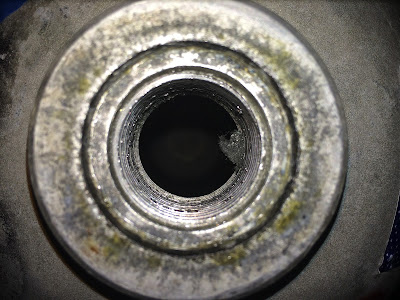By now we all know that visual inspections need to happen at least annually and hydrostatic inspections must occur at least every five years in the United States. But do you really know what is being inspected and why these inspections are done?
A visual inspection involves taking the valve off of a tank, placing a light source and sometimes a probe into the tank to look for any kind of corrosion, pitting, or other contaminates in the tank
 |
| It is amazing what you find in a tank. In this case, metal shavings and fuzz |
A visual inspection will also detect neck cracks or other imperfections in the tank construction before they fail.
A hydrostatic test is required by federal law in the United States every five years. This test involves filling a tank with water, pressurizing it, and measuring the expansion of the tank.
 |
| Our hydro station |
Caring for the tank is not very difficult. Make sure these tests are done on schedule, give them a quick fresh water rinse once in a while, avoid extreme temperatures and impacts to the tank. Most tanks have a life span measured in decades if they are cared for. But a tank is more than just the metal cylinder.
The valve is often forgotten when it comes to cylinder care. Valves have the hardest job of any piece of scuba gear. They must seal very high pressures and release it in a controlled manner time after time.
Valves must be cared for in many ways. Firstly, it is important never to over tighten the valve handle. The valve seat that makes the seal, closing the tank, does not need more pressure to seal; cranking the handle closed will only bend the valve stem. Valve stems should give you years of flawless service, but there is no way to repair a bent one and it must be replaced.
 |
| A bent valve stem |
Corrosion of the valve is another big concern. If water is introduced to the tank, it will cause the metals to corrode rather quickly.
 |
| A corroded dip tube |
An annual service of the valve involves disassembling the valve and cleaning all of the pieces individually.
Sometimes small leaks of air come from the valve handle. These are usually caused by an improperly maintained valve where the seat has worn, the o-rings are beginning to fail, or corrosion prevents proper sealing.
 |
| Corroded bonnet nut and valve stem |
 |
| A damaged crush washer and lots of corrosion |
Having your valve serviced regularly will guarantee many many years of operation. I recommend having it done at least annually, when the tank gets visually inspected is a good time for it. This is a service you may need to ask for since most tank service is usually done ala carte and not combined with other work.
Tank and valve repair can be rather technical requiring specialized tools and procedures
We at Hawaiian Diving Adventures are fully trained and equipped to keep your tanks happy and operational for many years to come. If your tanks are ready for service or they are suddenly making funny noises, call (808) 232-3193 or bring it in and we can take a look.


No comments:
Post a Comment